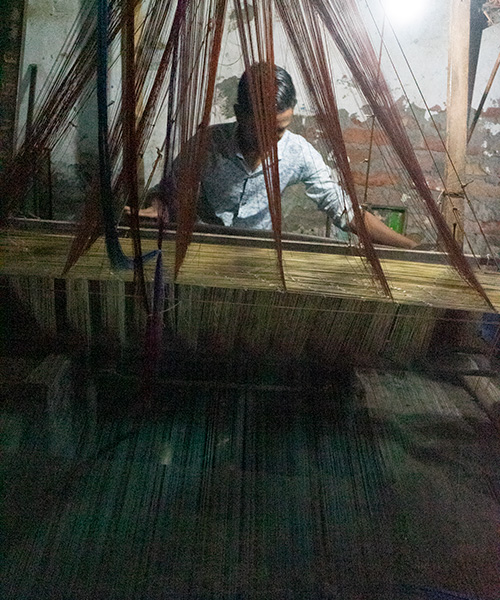Loose threads
| Weaving fantasy and disappointment. Workers and families share their struggles for acknowledgement. | ||
1. Search eternal
A dry pre-Maghrib hour and the emotional charge from Halima “Hum log insaann e hi hain?” “Are we not human?” lands exactly where intended: the territory of the unanswerable. Halima and Qurban Ali have been married for decades, with many of those years spent in a single room at the end of a narrow alley in one of the Mirpur camps for “stranded Pakistanis.” In pre-Partition India, Qurban Ali’s family lived in Kamarhati, West Bengal, “around an hour from Kolkata, from Raja Bazar,” adds Halima with relish for the details. Qurban Ali worked at a cotton mill; his first wife was from Kolkata. Now, 87 or 88, some of his senses have weakened. He has lost most of his eyesight; his hearing has diminished considerably. Halima, his second wife, who characterizes marriage generally as “jhelke raho” “hanging on”. (which she intends as dry wit, not bitterness), fills in Qurban Ali’s long pauses. And it is mostly through her that his, her, and their stories are communicated.

Photo by: Sushanta Kumar Paul
Born in East Pakistan, Halima’s mother was Bengali and her father Bihari from Muzaffarpur. Both were from India; both arrived here post-Partition. Halima remembers her mother had a hard time learning Urdu, though over time, she adapted. Halima learned Urdu from her father as Urdu was spoken at home, and she is just as adept at spoken Bangla, though she can’t read or write in the latter. At 71, her pluck intact, Halima speaks of several trips to India, the last of which was in 2004 before border regimes tightened. A return trip arranged through a dalal had cost only 1400 taka. On that last visit, a kind of
“girls’ trip” – with her brother’s mother-in-law – they went around the heady destinations of Kolkata, Eden Garden, Victoria Memorial, New Market; the market, however, was mostly a miss because it was a Sunday. A customary trip to Kamarhati had also been made, but Muzaffarpur was both too far and too empty with her father gone; now she was just an outsider, known to no one there.
Photo by: Sushanta Kumar Paul
As the hour of Maghrib approaches and sunlight and verve dissolve into sadness – unsupported and uncared for by their children and by the imposition of outsider status in her place of birth, – Halima picks out a rehel, one of a handful of cherished generational mementos. Her meager income from embroidery commissions is their only income. Few tokens of their life together survive, and there are barely documents of their conjugal life, says Halima, as they had always avoided being photographed. One exception, IDs they acquired in 2008. Qurban Ali muses: “In the past, it wasn’t as important but these days everything requires an ID. We can’t even get a proper burial, a place at the cemetery without one.” Marooned in these shores, Qurban Ali passed away on December 18, 2019, only weeks after this meeting.
2.Tenuous fabrics
In the labyrinthine networks of Mirpur Banarasi Palli, in the making of saris and stories, the threads unfurl, snap, loop, set to design, some discarded or tangled, are woven in many directions. The Banarasi saris are woven with silk and tales. Concentrated in Mirpur sections 10 and 11, many weavers are second and third-generation descendants of partition migrants living and working in Mirpur’s camps: the Banarasi Palli is synchronous with these camps. The looms are housed along with narrow air and light-starved warrens, hidden from the main roads. The weavers work 8 to 10 hours days making a sari a week for roughly 1,000 to 3,000 taka per sari. Rustam learned the craft “dekhe dekhe” From observation. starting as a helper, “everyone starts out as a helper,” he says, on their way to becoming weavers – if they can survive the grueling trade.
Photo by: Sushanta Kumar Paul
Co-workers echo his sentiment: “Times are tough these days. Once we were fine, but these days, with what we make, with the saris we make, it’s hard to go on like this. We don’t want our children to get into this business. Where’s the money? How do we survive? It’s impossible to support a family anymore in this line. The government hardly pays any attention to our interests. The quality of the saris has deteriorated; there’s no scope to nurture the craftspeople. We don’t have a trade union, nor is there any avenue to organize and collectively demand for our interests. There are a lot of weavers here but not as many as before. In our karkhana alone, there were once one hundred weavers. At present there may only be 10 to 12 karkhanas now, many of them in trouble, whereas we had 30,000 karkhanas only in this area.”
Photo by: Sushanta Kumar Paul
The word karkhana derives from Farsi to mean work (kar) and house (khana) in Bangla for what we know as a factory or workshop. In this etymological expression melding house and work, it is easier to locate the connective tissues of housing and work and, perhaps, the crumbling foundations are more apparent through this foregrounding. Another blurring occurs in the veins of karkhana: a word of Farsi origin adapted into Bangla signals a boundary-less linguistic tradition that evolved through the integration of multiple other languages. The word and its variations also appear in several other languages from Hindi to Urdu, Turkish, Bulgarian, and Romanian mirroring the circuits of cultural overlap and knowledge circulation before English dominated globalization.
